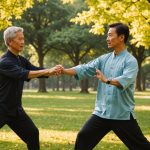Overview of Tai Chi and Its Historical Context
Tai Chi is a renowned practice with deep historical roots that trace back to ancient China. Originating as a martial art, its exact inception is elusive, but it is believed to have developed over centuries, blending various forms of Chinese philosophy and physical exercises. As a discipline, Tai Chi has evolved significantly from its traditional martial art roots into a widely practiced form of exercise known for its health benefits.
The history of Tai Chi is not just about its combative origins; it’s also about its transformation into a practice that emphasizes harmony and balance. This transformation reflects the cultural shift towards viewing physical practices as pathways to holistic well-being. Traditional Tai Chi practices focus on slow, deliberate movements and integrating breath control, which not only improve physical health but also enhance mental tranquility.
In parallel : Personalizing Nutrition: Harnessing Nutrigenomics for Effective Diets in Metabolic Syndrome Management
The cultural significance of Tai Chi is profound, particularly in promoting health. It embodies the principles of balance, coordination, and inner peace, contributing to overall wellness. Practitioners across the world embrace it for reducing stress and enhancing flexibility, aligning with its historical intent to foster both mental and physical vitality.
Cardiovascular Health and Middle-Aged Adults
For middle-aged adults, maintaining strong cardiovascular health is crucial as it often predicts future wellness. Heart disease remains a leading cause of mortality within this group, underscoring the need to prioritize heart health. During this stage, individuals often confront increasing risks of hypertension, high cholesterol, and arteriosclerosis—conditions that can lead to severe complications if left unchecked.
Have you seen this : Unlocking the healing power: the benefits of massage guns
Understanding these common issues is the first step. Hypertension, or high blood pressure, quietly damages arteries, increasing strain on the heart. Similarly, elevated cholesterol levels can lead to plaque buildup in arteries, heightening the risk of heart attacks. Arteriosclerosis, the thickening and stiffening of arterial walls, reduces blood flow and demands increased cardiac effort.
However, adopting proactive measures can bring substantial benefits. Regular exercise, a balanced diet rich in fruits and vegetables, and routine medical check-ups contribute massively to sustaining a healthy heart. By focusing on these lifestyle choices, middle-aged adults can reduce the risk of cardiovascular disease, ensuring improved quality of life and longevity. A strong commitment to heart health will not only protect but enhance overall well-being during the pivotal middle years.
Research Studies on Tai Chi and Heart Health
The exploration of Tai Chi’s benefits for cardiovascular health has garnered increasing attention in research studies. Key findings have consistently highlighted Tai Chi’s potential to enhance heart health by improving cardiovascular fitness, lowering blood pressure, and reducing stress. In a comparative analysis, studies observed that while both Tai Chi and aerobic exercises contribute positively to heart function, Tai Chi may offer unique advantages given its low-impact, meditative nature.
Several studies have placed Tai Chi alongside conventional exercises like walking or jogging. Notably, one study suggested that Tai Chi is as effective as moderate aerobic exercises in improving heart health, especially for older adults or those unable to engage in high-intensity workouts. Research supports the idea that Tai Chi’s gentle movements and focus on breathing provide cardiovascular benefits, combining physical activity with stress reduction.
Expert opinions emphasise the scientific validity of Tai Chi for heart health, pointing to its holistic approach. While more extensive clinical trials could solidify these findings, Tai Chi stands out as an accessible exercise regimen. As both exercise and meditation, it promotes cardiovascular well-being, making it a recommended option for diverse populations.
The Physiological Benefits of Practicing Tai Chi
Tai Chi is more than just a martial art—it’s a practice that blends movement and mind-body connection. One significant benefit is its ability to enhance blood circulation. The slow, controlled movements promote better flow of blood and oxygen, which can contribute to lowering blood pressure. This is particularly important for those seeking natural methods to maintain heart health.
Stress reduction is another critical feature of Tai Chi that directly impacts cardiovascular health. By focusing on gentle movements and rhythmic breathing, practitioners often experience a calming effect. This stress relief helps reduce cortisol levels, thereby lowering the risk of heart disease. Improved stress management through Tai Chi can lead to a healthier, more resilient heart.
Moreover, Tai Chi contributes to overall physical fitness and well-being. It is a low-impact exercise that enhances strength, flexibility, and balance without taxing the body excessively. Regular practice can improve muscle tone and stamina, making it a suitable choice for individuals of all ages. Thus, engaging in Tai Chi offers a harmonious balance of physiological benefits, promoting a healthier body and mind.
Instructional Guide for Beginners
Embarking on a journey in Tai Chi for beginners can be a rewarding pursuit. This ancient practice combines smooth, flowing movements with mindful attention. Learning the fundamental techniques can be both soothing and invigorating. It’s all about mastering basic movements and postures which serve as the foundation for more advanced practice.
Basic Movements and Postures
The initial postures in Tai Chi often include standing forms, such as the Wu Chi posture. This involves standing with feet together and arms relaxed, encouraging a calm mind. Movements like the “Ward Off” or “Grasp the Sparrow’s Tail” are common starting points. These techniques focus on coordinating breath with movements to foster a holistic sense of balance and tranquility.
Resources
As technology advances, accessing instructional videos becomes increasingly convenient. Platforms like YouTube offer free, detailed tutorials from Tai Chi masters, suitable for beginners. Moreover, online classes provide opportunities for interactive and guided practice.
Tips for Regular Practice
To effectively incorporate Tai Chi into your fitness routine, it’s essential to practice consistently. Start with short, daily sessions to build muscle memory and improve fluidity. Setting aside a specific time each day can help integrate Tai Chi seamlessly into life, paving the way for improved physical health and mental well-being.
Personal Testimonials and Success Stories
Hearing about personal experiences can be incredibly motivating for those beginning a Tai Chi journey. Jane, a long-time practitioner from Manchester, attributes her significant health improvements to this ancient practice. She reports enhanced flexibility and stress relief after a regular six-month routine of Tai Chi.
Testimonials like Jane’s are common. Michael, a Tai Chi teacher in London, shares stories of students who have experienced reduced chronic pain and improved mood through consistent practice. He notes the dedication of his students is often spurred by seeing tangible results, which reinforces their commitment to Tai Chi.
For many, the motivational factors are simple but profound: a desire for increased well-being and personal transformation. Tai Chi practitioners often find the practice becomes more than an exercise routine; it becomes a holistic approach to life. In several testimonials, individuals mention how Tai Chi has helped restore a sense of balance and calm, empowering them to navigate life’s challenges with confidence and resilience.
These real-life success stories not only highlight the benefits of Tai Chi but also inspire others to start and sustain their journey toward healthier living.
Expert Interviews on Tai Chi and Health
Engaging health professionals and Tai Chi practitioners, we unearth valuable insights regarding the impact of Tai Chi on health. Health professionals emphasize its multifaceted benefits, particularly in promoting flexibility, balance, and mental well-being. According to them, Tai Chi facilitates increased awareness and reduces stress levels, which is highly beneficial for both physical and mental health.
Moreover, Tai Chi practitioners provide unique perspectives on its teaching methods. They focus on the gentle nature of Tai Chi movements which make it accessible for individuals of varying fitness levels. The emphasis remains on harmony and fluidity, which encourages learners to engage consistently at their own pace.
The integration of Tai Chi in wellness programs is a topic of growing interest. Discussions highlight how such inclusion fosters a holistic approach to health, combining physical activity with mental relaxation techniques. It is often seen as a practical addition, supporting both preventative health measures and rehabilitation processes.
Overall, the blend of expert insights and real-world practices underscores Tai Chi’s practical benefits, making it a popular choice for enhancing general health and well-being.
Overview of Tai Chi
Tai Chi, a timeless martial art, intertwines movement and meditation. Its roots trace back to China, dating over 1000 years ago, deeply ingrained in Chinese culture. Originally developed for self-defence, it has evolved to focus more on health and well-being.
History of Tai Chi
Rooted in the philosophy of Taoism, Tai Chi emphasizes balance and harmony within oneself and with nature. It began mainly as a martial art but grew into a method to enhance one’s health, showing the power of its adaptable approach. Each style of Tai Chi offers distinct characteristics and benefits.
Different Styles of Tai Chi
There are several Tai Chi styles, each with its unique features:
- Yang Style: Known for its graceful, slow movements, it’s popular globally and accessible for beginners.
- Chen Style: Incorporates explosive movements, tracing back to the art’s origins.
- Wu Style: Focuses on micro-movements, emphasizing subtlety and relaxation.
Tai Chi Benefits
Tai Chi offers profound physical and mental benefits. Regular practice can improve flexibility, strength, and balance. Mentally, it fosters relaxation and reduces stress, promoting a sense of internal peace and clarity. This holistic approach makes Tai Chi a valuable practice for many seeking improved health.
Connection Between Tai Chi and Cardiovascular Health
Delve into the Tai Chi benefits for enhancing cardiovascular health. Practising Tai Chi is known to positively affect heart health by promoting an optimal heart rate and improving blood circulation. This gentle martial art encourages slow, deliberate movements, which, when performed regularly, can lead to more efficient oxygen distribution in the bloodstream. Consequently, better circulation supports the heart in maintaining a healthier rate, lowering the risk of cardiovascular diseases.
Furthermore, Tai Chi is a formidable technique for stress reduction, a crucial component in optimizing heart health. It fosters mental serenity through deep breathing and mindful movement, lowering cortisol levels and thereby reducing heart strain. The focus on calmness and balance makes it an excellent preventative measure against stress-induced heart conditions.
When comparing Tai Chi to other forms of exercise, its low-impact nature is particularly beneficial for individuals seeking a gentle yet effective means of improving cardiovascular health. Unlike high-intensity workouts, Tai Chi provides heart benefits without putting undue stress on the joints or muscles, making it accessible to a wide range of practitioners, including those with physical limitations.
Relevant Research Findings
Ample Tai Chi Evidence suggests numerous health enhancements through focused studies.
Overview of Key Studies
Several research studies have underlined the multifaceted health benefits linked to regular engagement with Tai Chi. These studies collectively point towards improved balance, muscle strength, and overall well-being. Utilising precise metrics, researchers have evaluated and validated these improvements.
Findings on Cardiovascular Improvements
Specific investigations into Tai Chi’s impact reveal marked cardiovascular benefits. A significant study demonstrated increased heart rate variability and reduced blood pressure among participants, indicating better cardiovascular health. This underscores Tai Chi’s potential as a supplementary approach for improving heart function and reducing risks related to cardiovascular diseases.
Long-term Health Impacts of Regular Practice
The long-term health implications of consistent Tai Chi practice are expansive. Research highlights consistent routines improve cardiovascular function and contribute to mental health benefits, stress reduction, and enhanced immune response. Middle-aged adults, in particular, experience notable improvements due to tailored movements enhancing body awareness without causing strain. These findings advocate integrating Tai Chi into regular exercise regimes, promoting sustained health benefits and a higher quality of life.
Through these insights, Tai Chi emerges as a promising, practical addition to health-focused lifestyle routines.
Personal Testimonials
Tai Chi has touched the lives of many, and the anecdotal evidence from practitioners paints a vivid picture of its benefits. Several individuals attribute their improved heart health directly to their regular Tai Chi practice. One such story involves a former athlete who, after suffering a heart attack, embraced Tai Chi after reading positive community feedback. Within months, his doctor noted lower blood pressure and improved cardiovascular endurance—a transformation he proudly shares with his Tai Chi peers.
For others, the profound success stories center around overall health transformation. One woman, battling chronic fatigue, experienced a resurgence in energy levels and mental clarity due to consistent Tai Chi sessions. Her personal blog, focused on her journey, has inspired fellow practitioners to seek similar outcomes.
Group Tai Chi classes offer more than just physical benefits. The sense of belonging found within these communities fosters collective motivation and resilience. Many participants express that the positive atmosphere and shared experiences greatly enhance their commitment to the practice. The community feedback from these classes is overwhelmingly positive, with frequent mentions of improved social connections and emotional well-being. These testimonials serve as inspiring motivation for anyone considering joining a Tai Chi community.
Practical Tips for Beginners
Starting your journey with Tai Chi can be an exciting yet daunting experience. As a beginner, understanding the foundational elements is crucial for effective practice. Focus on Tai Chi basics, such as maintaining proper posture and breathing techniques. Remember, consistency is key—so practice regularly to see notable improvements.
When looking for instructional tips, consider joining a local class or exploring online tutorials. Classes offer direct interaction with instructors, providing immediate feedback and personalized instruction. This can significantly enhance your understanding and execution of movements. Alternatively, online videos and tutorials are convenient, allowing you to practice at your own pace.
Integrating Tai Chi into your fitness routine doesn’t have to be overwhelming. Start by setting aside a dedicated time each day for practice. Ideally, practice either in the quiet of the morning or the tranquility of the evening. Begin with short sessions and gradually increase the duration as you become more comfortable.
Incorporate these practices:
- Allocate a specific time daily for Tai Chi
- Use online resources as supplements
- Engage with a community or class for motivation
Adopting these practices can make the journey of learning Tai Chi more enjoyable and fulfilling.
Safety Considerations
Engaging in Tai Chi is generally a safe practice, though misconceptions can lead to concerns about its safety. A common misunderstanding is that its slow movements imply zero risk of injury. In reality, while the risk is low, health precautions should be taken to prevent muscle strain and other injuries.
For beginners, it is crucial to focus on proper technique. Here are a few injury prevention tips:
- Start with foundational forms to build strength and flexibility.
- Gradually increase intensity to allow the body to adapt safely.
- Listen to your body’s signals; discomfort can indicate the need to adjust technique or intensity.
In certain cases, consulting with a healthcare provider prior to starting Tai Chi can be beneficial. Individuals with pre-existing conditions, such as joint issues or severe osteoporosis, should seek medical advice to tailor the practice to their unique health needs. Even healthy individuals can benefit from guidance to enhance the practice’s safety and effectiveness.
Taking these health precautions will maximise the health benefits while minimising potential risks associated with Tai Chi practice.
Recommendations for Suitable Routines or Classes
Exploring Tai Chi Classes can greatly benefit those looking for balance and mindfulness. Tailoring your exercise to meet both physical and mental needs is crucial. Utilizing Community Resources or getting routine suggestions can help guide you on this journey.
Finding a Class
Locating the right class is essential. Many cities offer Tai Chi Classes through Community Resources, often available at local gyms, parks, or community centres. Check community bulletin boards or local websites for upcoming classes. When choosing, look for a class level that matches both your experience and fitness level. A beginner course will focus on fundamental movements, while advanced sessions may involve complex sequences.
Online Resources and Apps
If you prefer practicing at home, the internet offers a wealth of options. Numerous websites and apps provide comprehensive Tai Chi sessions. Look for platforms that offer high-definition videos and detailed instruction. Some apps offer customisation features to tailor your session to your health and current skill level, adding flexibility and accessibility to your practice.
Tailored Routines for Middle-Aged Adults
Specially designed routines for middle-aged individuals are available, focusing on improving balance, flexibility, and heart health. These routines incorporate slow, deliberate movements, making them ideal for ensuring a gentle but effective workout. Consult with your healthcare provider to ensure these activities align with personal health goals.











